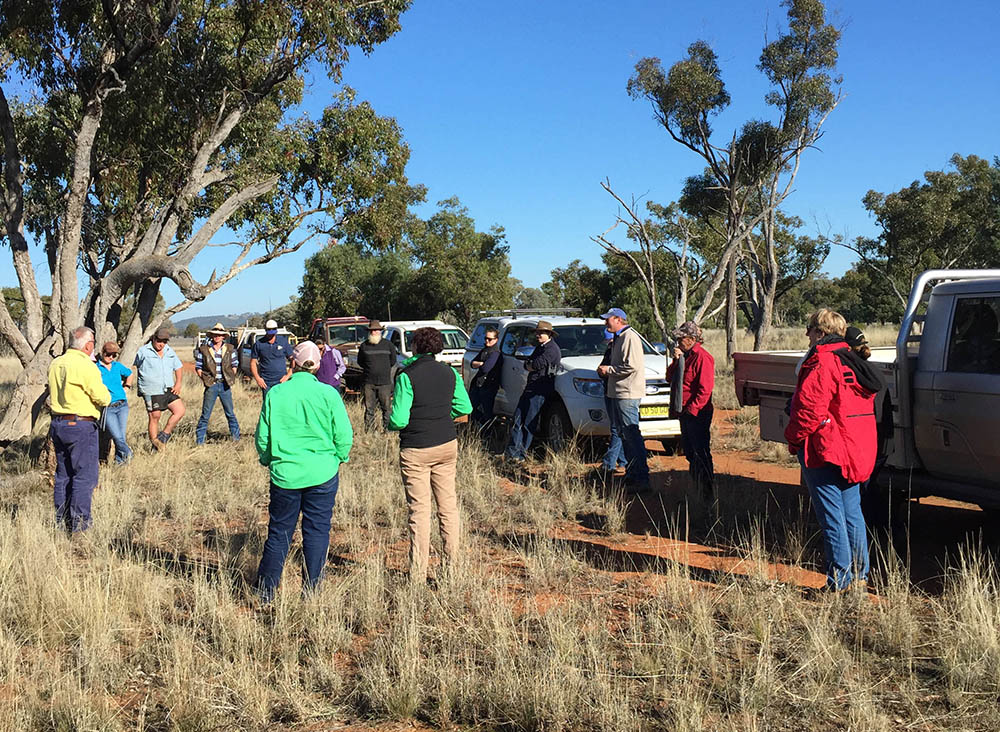‘Seeing Beyond the Wood and Trees for the Grass at Wynwood Station‘
A recent property tour incorporating an ANPC native plant identification and vegetation management workshop was held at Wynwood Station north of Mount Hope, NSW on 14 June 2017. Local landholders and interested community group members were invited to attend this workshop, with support from Western Local Land Services. You know it’s been a good field day when one of the landholders attending takes the time to fill out the feedback form with “one of the best practical field days I’ve been to, top stuff”!!
ANPC Project Manager, Martin Driver, was the presenter. A grazier himself, Martin highlighted the importance of indicator species such as perennial grasses and how you can use these plants as a tool to assist with your grazing decisions. How this day exceeded the usual expectations was by incorporating a focus on grazing management, and weed and Invasive Native Shrub (INS) control and management, all issues that are at the forefront of many graziers’ minds in the Western LLS region.
The day started with an inspection of a site with beautiful stands of mature Western Red Box (Eucalyptus intertexta) and aged regrowth Poplar/Bimble Box (E. populnea), with a mixed understorey of Wilga (Geijera parviflora), shrubs and a diverse native grass layer. This set the scene to outline the ecology of these woodlands and the response to the visible “ringing’ of the large trees in the 1870’s, the historical overgrazing by domestic and feral animals, the removal of grass fuel and fire, and the subsequent invasion of native shrub and tree species. The importance of maintaining a diverse, species rich and productive perennial grass base was discussed, along with key grass palatability/nutritional and grazing response issues, as well as the use of patch fire as a supplementary management tool. Due to effective use of controlled cattle grazing and subdivisional fencing there was a magnificent range of native grass species present including Curly Windmill (Chloris truncata), Mulga Grass (Aristida contorta), Bandicoot Grass (Monachather paradoxa), Spear Grass (Austrostipa sp). and even Kangaroo Grass (Themeda triandra).
A range of other vegetation communities, species and management issues were inspected and discussed. The importance of management of INS as opposed to eradication, and where and how to identify where you concentrate your efforts and resources, was a key element in maintaining the natural resources and a diversity and regeneration of the valuable species. Martin then discussed how these decisions have been beneficial in getting to the stage his property is at now, which was really beneficial in tying it all together.
One of the many highlights of the day was how forthcoming everyone was with sharing their experiences and frustrations, and helping one another to move towards desired goals such as increased ground cover, an increase in palatable species, a reduction in INS or reduced thistle incursions. John Vagg from Wongaroa Station simplified exactly what graziers are trying to do, “convert sunlight into money” and identified how days like this are so beneficial to their business to assist them to identify the mix of species they have and manage their business accordingly.
It was a great opportunity to spend time with inspiring landholders and the feedback was very positive. Having the opportunity to see the response of the country to recent management decisions by the landowners was a privilege and a great learning experience.
Jasmine Wells, Western LLS and Martin Driver, ANPC.
Western LLS will be running another plant identification workshop west of Hillston later in the year. Any inquiries or suggestions can be directed to Jasmine Wells, 0417488496 or Shae Brennan 0447 337 653.
Martin Driver (left) at the Plant ID Workshop at Wynwood Station. (Photo: Jasmine Wells)


